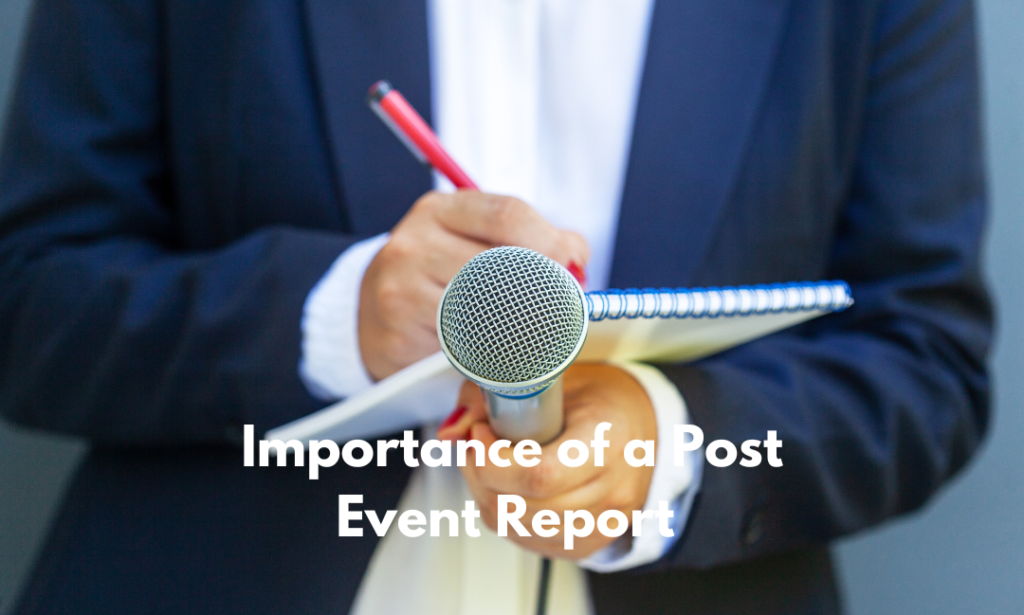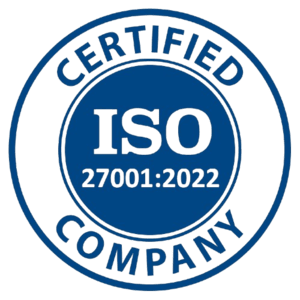
Each event serves as an opportunity to improve your event performance and experience, and this is where the post-event report comes into play.
It is a comprehensive analysis of the key aspects of your event, including the goals, budget, attendance, and overall success of the event. Creating the summary report will help you to analyze what steps you need to take in your next event to address the gaps and deliver exceptional events consistently.
Here’s a comprehensive guide on how to go about structuring a post-event report. But before we get to that, let us understand the role that the post-event report plays, and why it is important, in more detail.
Importance of a Post Event Report

As mentioned, the post-event report, also known as the event summary report, gathers the success metrics that reflect on the performance of the event you just hosted. This report can be used to follow up with the company executives, speakers, partners, sponsors, and even attendees. Understanding if or not you achieved the event goals, and how effectively they were achieved can help all stakeholders calculate their event ROI.
The data that you can generally find in a post event report are –
- The number of registrations and attendance rate
- Viewership data, which can include – impressions, and for how many minutes the live webinar is being seen, etc.
- Most popular content
- Attendee demographics
- Attendee engagement – includes how they are interacting in chats, answering to the polls, and QA sessions.
- Social media reach
- Expenses and ROI
And so much more, depending on how powerful your event platform’s analytical capabilities are.
Here is what you stand to gain by crafting a thorough post-event summary report.
Demonstrating the Event’s Success
After dedicating significant time and resources to organizing an event that has been months in the planning, it’s crucial to assess if or not all your efforts have been paid off. A post-event report provides a comprehensive overview of your company’s return on investment (ROI), showcasing detailed insights through numbers, charts, and tables.
It also evaluates how well the event met the key performance indicators (KPIs) and goals you set out to achieve. And considering how many stakeholders are involved in successfully delivering an event, it is vital to analyze data to determine each of their return on investment and scope for improvement.
Guides Future Event Planning
A post-event report is an essential resource for enhancing your event planning process. By thoroughly analyzing the details of your recent event, you can identify areas for improvement. This insight enables you to plan and execute future events more effectively and strategically.
This in-depth evaluation highlights what elements were successful and which areas fell short of expectations. With this critical information in hand, you can make informed adjustments and improvements, paving way for even greater success in your upcoming events.
Helps Identify Opportunities for Improvement
A post-event report is essential to deliver consistently successful and high-impact events. By examining performance metrics such as viewership and engagement, you gain a clearer understanding of which content and topics resonate best with your audience. This analysis also sheds light on aspects like optimal event topics, speakers, content format, timing and necessary technological upgrades.
Armed with these insights, you can set more precise KPIs and objectives for your upcoming events, driving continuous improvement and increasing the chances of success.
Also Read – What kind of analytics report is generated by Airmeet?
How to Create an Effective Post Event Report

Now that we’ve discussed the significance of a post-event report, it is important to understand the elements that contribute to creating a solid one. Here’s a step-by-step guide to creating an effective post-event report.
Establish a Data Tracking System for your Event
Managing and tracking your event is significantly simpler by setting up a solid data tracking process. Take notes on key occurrences and capture “behind-the-scenes” data that might be critical to the outcome to enrich your report.
Utilizing a virtual event platform that automatically gathers data in the background can be incredibly valuable, providing you with essential insights effortlessly.
Focus on Essential Data
Make sure to include only the most crucial information in your report, to maximize its impact. Emphasize the key metrics and insights that are most relevant to stakeholders, offering a clear summary of the event’s outcomes.
For those who seek more detailed information, you can provide a thorough appendix to cover all the finer data points and metrics.
Create your Report
Now create the report where you need to include –
- An executive summary – The executive summary provides a brief overview of your report, summarizing the key highlights and data in under one page. It should cover the event’s objectives, KPI achievements, a budget summary, and key recommendations. Although it’s placed at the beginning of the report, it’s best to draft it last.
- Showcase Top Content with Viewership and Engagement Data – List your most popular content, including top live and on-demand sessions and speakers, along with their viewership and engagement metrics. Focus on the top 5 in the main report and include the full list in the appendix, ranking sessions by viewers, watch time, and engagement rate.
- Provide Participant Demographics and Registration Data – Include key details on attendee demographics and registration, such as location, viewing times, and breakdowns by country, company, industry, age, and gender. This helps stakeholders evaluate if the event reached the intended audience.
- Quantify Media Exposure – Brand visibility extends beyond the event itself, so it’s crucial to capture the full extent of media exposure. Include data on both paid campaigns and organic posts, detailing impressions, click-through rates (CTR), and engagement rates to provide a comprehensive view of the event’s reach.
- Assess Participant Engagement – Provide an overview of attendee engagement, including engagement rates, reaction breakdowns (likes, applause, emojis), and the number of people who added sessions to their personal calendars.
Incorporate Visuals
Enhance the readability and impact of your report by incorporating a variety of visuals, including graphs, infographics, tables, charts, and images. These elements help to convey complex data more clearly and make the report more engaging.
Visuals break down information into easily digestible segments, allowing readers to quickly grasp key insights.
By presenting data visually, you enable readers to easily understand otherwise complex data from the graphical representation, making the report both informative and accessible.
Proofread
Ensure your event summary is visually compelling and clear. Use graphs and other visuals to illustrate data, keeping text minimal.
Thoroughly proofread to eliminate any spelling or punctuation errors, ensuring your report is both professional and easy to understand.
Distribute it among your Stakeholders
Use this opportunity to express your gratitude to all stakeholders for their participation in the event, and to maintain relationships for future engagements.
Send the event summary in a personalized email, highlighting key results relevant to each stakeholder and outlining the next steps in your partnership.
Also Read – Post-Event Email Template For Attendees, Speakers, Hosts, & Sponsors
Tips for Creating an Effective Post Event Report

When compiling a report on the success and challenges of an event, follow these key practices:
- Ensure Thoroughness: Collect a comprehensive set of data and information for accurate analysis.
- Maintain Objectivity: Base your findings and conclusions on data and feedback, avoiding subjective opinions or guesstimation.
- Be concise: Keep the report focused and digestible by avoiding unnecessary repetition and lengthy explanations.
- Use Visuals: Incorporate charts and graphs to present data in a concise and visually engaging way.
- Provide actionable recommendations: Include insights and suggestions for future improvements based on the lessons learned from the event.
Common Mistakes to Avoid While Crafting a Post-Event Report
Well, it is fair to assume that creating the ideal report involves a bit of trial and error, but here are some things to avoid while crafting your post-event report.
- Ensure Data Collection: Avoid incomplete data by first gathering all pertinent data points and relevant information. Utilize your event management software to secure accurate data, because your end report is only as good as the data you use to create it.
- Maintain objectivity: Refrain from subjective analysis or personal opinions. Base your findings strictly on factual data to ensure the report remains impartial and reliable.
- Acknowledge Challenges: Be transparent about any difficulties or failures encountered during the event. This honesty demonstrates a commitment to improvement and avoids glossing over important issues.
- Incorporate Stakeholder Feedback: Include inputs from key stakeholders to provide a well-rounded evaluation of the event’s success. Ignoring this feedback can lead to an incomplete assessment.
- Offer actionable insights: Ensure the report provides practical recommendations for future events, derived from the lessons learned. This helps guide future planning and improvement.
Bottom Line
The more thorough and in-depth your post-event report, the greater the chances of making your upcoming event a successful one. Remember that just creating an event report with the event summary won’t work; rather, you need to acknowledge its importance in your overall event marketing strategy and create one that serves as a guide for upcoming events. This will also help your stakeholders to calculate their ROI and collaborate with you in your next event.
FAQs
Clearly describe each challenge encountered and its impact on the event. Detail the steps taken to address these issues and any lessons learned. Providing suggestions for avoiding similar problems in future events can also be valuable for continuous improvement.
The report should have a professional and organized layout, with clear headings and subheadings. Use visuals like charts and photos to illustrate key points. Ensure that the language is concise and the formatting is consistent throughout the document.





























